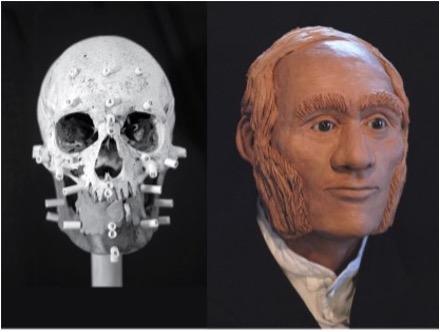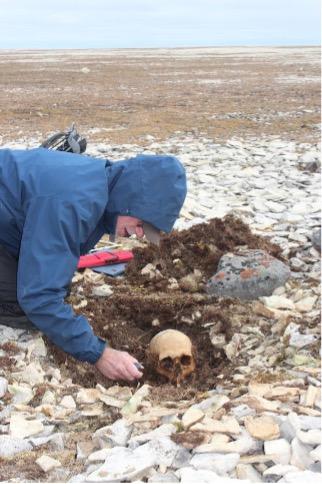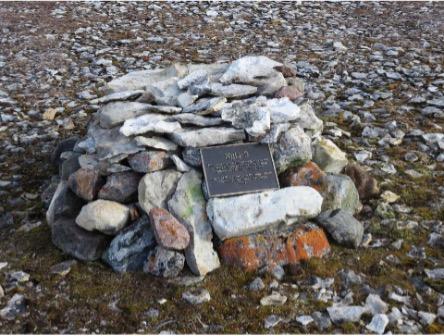When you purchase through links on our site , we may realise an affiliate commission . Here ’s how it works .
On July 9 , 1845 , John Gregory , an engineer on an ocean junket to theArctic , wrote a missive to his wife , Hannah , from a halt in Greenland .
That was the last fourth dimension his kin would take heed from Gregory , who , along with 128 others , perished after their ship became trapped in the Arctic glass . Now , usingDNAfrom his descendent , researchers have distinguish Gregory ’s remains , the first from the badly - destine excursion to be linked to a name , according to a new study .

A facial reconstruction of John Gregory, the first explorer from the disastrous 1845 Franklin expedition to have his remains identified.
In May 1845 , 129 officer and crew , under the dictation of Sir John Franklin , set sail from England aboard two ship — the HMS Erebus and the HMS Terror — to explore the Northwest Passage that plug in the Atlantic and Pacific oceans through the Canadian Arctic .
The polar expedition was intend to become the deadliest in account .
relate : In photos : Arctic wreck clear 170 - year - old mystery

Study co-author Douglas Stenton excavates the remains of another explorer found with the remains of John Gregory, but who has yet to be identified.
tragedy struck when the ship became trammel in the Canadian Arctic off King William Island in September of 1846 ; some of the crew died while stuck on the ship . But 105 crew members survived on the ship ’s supplies and eventually decided to give up ship , agree to astatementfrom the University of Waterloo .
The last known communicating was a inadequate banknote on April 25 , 1848 that was later find in a stone cairn on the island near the ships , that indicated the explorer ' intent to abandon their ships and move in the south to a trading post on the mainland , Live Science antecedently reported . They all perished without making it very far .
Since the disaster , archaeologists have discovered the remains of heaps of the explorers scattered in the surface area , most of them on King William Island , along their planned escape route . Although historians have cognise the names of those who were aboard the ships , none of the skeletons had been identified . To date , scientists have been capable to press out DNA from 27 of the hostile expedition members .

The remains of John Gregory and two other members from the expedition are contained in this commemorative cairn at Erebus Bay constructed in 2014.
In the new subject , the researcher identify , for the first time , the DNA taken from tooth and off-white samples of one of three corpse found on Erebus Bay , on the southwest shoring of King William Island , as belong to engineer John Gregory , who sail aboard the HMS Erebus .
The equal DNA came from one of Gregory ’s live descendants , a cracking - bang-up - neat grandson who live in Port Elizabeth , South Africa , and bears the same name — Jonathan Gregory .
— Photos : Drilling into Antarctic subglacial Lake Mercer

— Photos : Deep - sea expedition discovers urban center of devilfish
— In photos : Expedition Everest reveals awe-inspiring wildlife
The identification makes IE Gregory ’s story clearer than all of the others : He endure for three years on the ice - locked ship and died about 47 miles ( 75 kilometers ) south at Erebus Bay while trying to scat .

" Having John Gregory ’s remain being the first to be identified via genetic analysis is an incredible Clarence Shepard Day Jr. for our family , as well as all those interested in the badly - plump Franklin outing , " Gregory ’s outstanding - great - corking grandson said in the statement . " The whole Gregory family is extremely grateful to the entire enquiry team for their allegiance and toilsome workplace , which is so vital in unlocking pieces of history that have been freeze in sentence for so long . "
The researchers , in crook , were grateful for Gregory ’s kin for provide deoxyribonucleic acid samples and share their family ’s history , report cobalt - author Douglas Stenton , an appurtenant professor of anthropology at the University of Waterloo , said in the instruction . " We ’d like to encourage other descendants of penis of the Franklin expedition to touch our team to see if their DNA can be used to identify the other 26 individual . "
The findings were publish April 28 in the journalPolar Record .

to begin with issue on Live Science .














